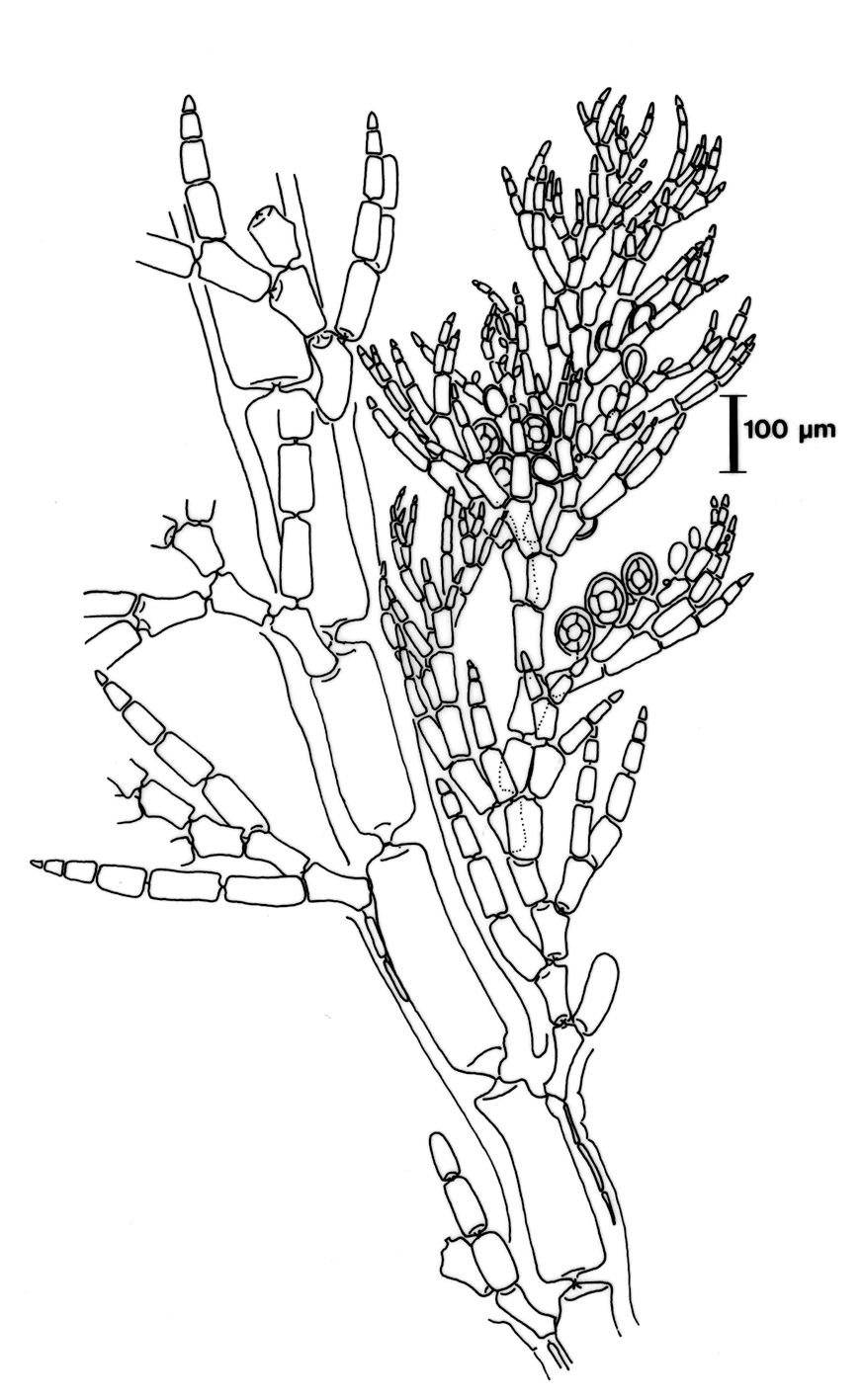Seaweeds of the South African South Coast


Order Ceramiales
Family Callithamniaceae
Callithamnion collabens (Rudolphi) L.McIvor & Maggs 2002: 443
Plants on the South African south coast up to a few cm tall (on the west coast up to 30 cm). Usually with an endophytic base and a single or a few erect axes, no creeping filaments. No clear distinction between indeterminate and determinate branches, but laterals often much shorter than the main axis. Main axis and branches corticated by rhizoidal filaments, developing from the basal cells of laterals. Main axis up to 300 µm in diameter. Laterals one per segment, densely branched almost every segment, in actively growing parts to two cells beneath the apex. Laterals in roughly four rows. Apical cells pointed, in younger stages terminated by a hair. Polysporangia one per cell on the ultimate and sub-ultimate branches, round or oval, measuring ca. 70x60 µm and dividing into 8 or 16 spores. Male stands perfectly round, in much the same position as polysporangia, one spermatangial cluster per cell, at maturity ca. 50 µm in diameter, producing many spermatangia. Procarps develop a little distance beneath the apical cells of the branches, and produce twin gonimolobes from each of the two auxiliary cells – or only from one as the auxiliary cell from the supporting cell fails to develop. Mature carposporophytes naked, up to ca 250µm in diameter.
Collections, ecology and regional distribution
Common along the entire west coast and extending onto the south coast (but less common) as far as the Port Alfred area (1-39). Epiphytic on larger algae in the lower eulittoral and below.
World distribution: Also known from Namibia (Rull Lluch 2002) and Sri Lanka (Silva et al. 1996).
Type locality: Table Bay or Gordons Bay, (Western) Cape Province, South Africa (Silva et al. 1996).

Callithamnion collabens 1. Detail of thallus with polysporangia. Reproduced from Stegenga et al. (1997)(as Aristothamnion collabens).
References Callithamnion collabens
McIvor, L., Maggs, C.A. & Stanhope, M.J. 2002. RbcL sequences indicate a single evolutionary origin of multinucleate cells in the red algal tribe Callithamnieae. Molecular Phylogenetics and Evolution 23: 433-446.
Rull Lluch, J. 2002. Marine benthic algae of Namibia. Scientia Marina 66 (Supplement 3): 258 pp.
Silva, P.C., Basson, P.W. & Moe, R.L. 1996. Catalogue of the benthic marine algae of the Indian Ocean. University of California Publications in Botany 79: 1-1259.
Stegenga, H., Bolton, J.J. & R. J. Anderson. 1997. Seaweeds of the South African west coast. Contributions from the Bolus Herbarium 18: 655 pp.
Cite this record as:
Anderson RJ, Stegenga H, Bolton JJ. 2016. Seaweeds of the South African South Coast.
World Wide Web electronic publication, University of Cape Town, http://southafrseaweeds.uct.ac.za; Accessed on 13 January 2026.